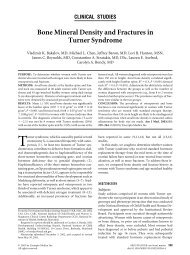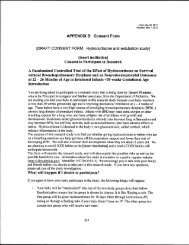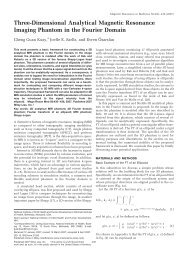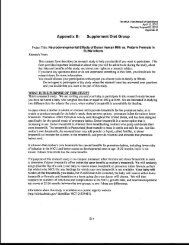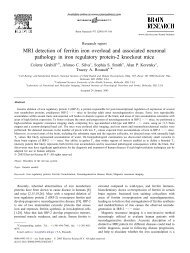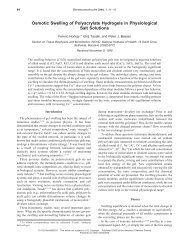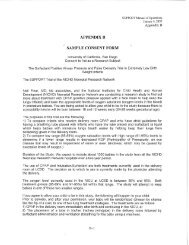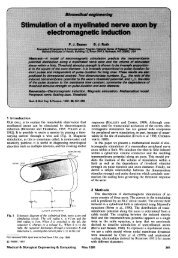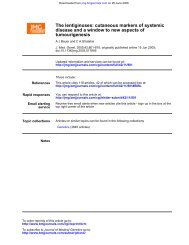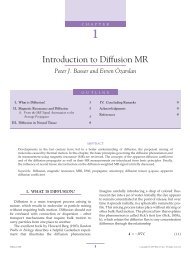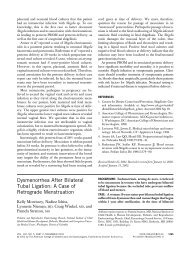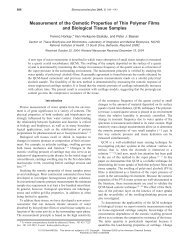A Mouse Model for the Carney Complex Tumor Syndrome Develops ...
A Mouse Model for the Carney Complex Tumor Syndrome Develops ...
A Mouse Model for the Carney Complex Tumor Syndrome Develops ...
- No tags were found...
Create successful ePaper yourself
Turn your PDF publications into a flip-book with our unique Google optimized e-Paper software.
Cancer Research<strong>for</strong> <strong>the</strong> o<strong>the</strong>r antigens was done without antigen retrieval. All slides weredeveloped with Vector Elite ABC reagents (Vector Laboratories, Burlingame,CA). For fluorescence in situ hybridization (FISH) analysis, tumors weresnap frozen in isopentane/liquid nitrogen, and touch preps were preparedon thawed samples. FISH was done as described (17) using a mouse BACcontaining <strong>the</strong> entire Prkar1a gene.ResultsGeneration of conventional and conditional null alleles <strong>for</strong>Prkar1a. To characterize <strong>the</strong> basis <strong>for</strong> PRKAR1A-associatedtumorigenesis in an animal model, we generated mice carryinga floxed copy of exon 2 of <strong>the</strong> murine Prkar1a gene. This exon,which contains <strong>the</strong> initiator ATG codon, was selected because<strong>Carney</strong> complex patients frequently show mutations affectingexon 2 (3, 4). The targeting vector (Fig. 1A) contained a total of9.3 kb of genomic DNA isolated from a mouse BAC carrying <strong>the</strong>entire Prkar1a gene (data not shown). The mouse Prkar1a genehas been shown to use five alternative noncoding first exons,designated as exons 1a to 1e (14), all of which were in <strong>the</strong> clonedDNA fragment. The targeting construct was genetically engineeredto contain a 5V loxP site between exons 1b and 1c as well as afloxed neomycin resistance cassette that was located in intron 2after homologous recombination. Mice carrying <strong>the</strong> targeted allele(Prkar1a flox-NEO ) were phenotypically normal and homozygotesexhibited no abnormalities up to 1 year of age (data not shown).However, owing to previously reported problems caused by <strong>the</strong>presence of <strong>the</strong> neomycin resistance cassette within genes (18),mice were crossed with <strong>the</strong> EIIA-cre line (16) to obtain micecarrying all possible alleles resulting from cre-mediated recombination(data not shown; ref. 19). This led to <strong>the</strong> isolation ofboth <strong>the</strong> deletion allele Prkar1a D2 and <strong>the</strong> cognate conditionalallele Prkar1a loxP (Fig. 1B). To verify that <strong>the</strong> Prkar1a D2 was infact a null allele, Prkar1a loxP/loxP mouse embryonic fibroblasts wereprepared and treated in vitro with cre recombinase. 7 Afterverification of <strong>the</strong> resulting Prkar1a D2/D2 genotype, proteins wereWestern blotted to show <strong>the</strong> complete absence of Prkar1a protein(Fig. 1C). In addition, Prkar1a D2/+ mice were intercrossed, andgenotyping of <strong>the</strong> litters revealed no Prkar1a D2/D2 pups. Embryoswere prepared at E9.5, and analysis of <strong>the</strong> litters showed that allPrkar1a D2/D2 embryos exhibited advanced stages of tissuebreakdown (Fig. 1D), confirming that <strong>the</strong> Prkar1a D2 allele wasembryonic lethal in <strong>the</strong> homozygous state. This embryoniclethality has been characterized previously in detail <strong>for</strong> a differentnull allele of Prkar1a (20). This observation, coupled with <strong>the</strong>in vitro data described above, indicates that <strong>the</strong> Prkar1a D2 allele isa null allele. Because of <strong>the</strong> close similarity between ourhomozygous null embryos and <strong>the</strong> previous report, we electednot to characterize <strong>the</strong> embryonic phenotype fur<strong>the</strong>r but ra<strong>the</strong>r tofocus <strong>the</strong> remainder of our ef<strong>for</strong>ts on analysis of <strong>the</strong> tumorigenicphenotype of <strong>the</strong> heterozygous mice.<strong>Tumor</strong>igenesis observed in Prkar1a D2/+ mice. To determineif mice carrying Prkar1a D2 exhibited tumorigenesis in a patternsimilar to human patients, mice were maintained in a pathogen-freeenvironment without intervention. We observed <strong>the</strong> mice <strong>for</strong> up to2 years, and in<strong>for</strong>mation from 44 Prkar1a D2/+ mice and 22 agematchedcontrols is included in this report. Visible solid tumorswere commonly observed in Prkar1a D2/+ mice of 8 to 12 months of7 K.S. Nadella and L.S. Kirschner, in preparation.age, although <strong>the</strong>y were seen as early as 5 months and as late as 21.5months (Table 1). In rare cases, <strong>the</strong> tumors had a s.c. cysticcomponent adherent to <strong>the</strong> mass (data not shown). The mostcommon location <strong>for</strong> <strong>the</strong>se lesions was on <strong>the</strong> proximal hind limb(Fig. 2A), although <strong>the</strong>y were also seen elsewhere, including <strong>the</strong><strong>for</strong>elimb, head, and paw (Figs. 2B and 5D). For <strong>the</strong> majority of <strong>the</strong>setumors, histopathologic examination revealed that <strong>the</strong>y weremoderately cellular and composed of interlacing bundles of parallelspindle cells (Fig. 2C). <strong>Tumor</strong> cells exhibited modest pleiomorphism,although mitotic figures and nuclear palisading were rare. Scatteredthroughout <strong>the</strong> tumors were large cells containing variably sizedhighly eosinophilic cytoplasmic granules with an appearanceconsistent with hypertrophic Schwann cells (Fig. 2C). Immunohistochemicalanalysis (Fig. 2D-F) showed diffuse S-100 staining andpatchy staining <strong>for</strong> NSE and GFAP. Based on <strong>the</strong>se characteristics,<strong>the</strong>se tumors were classified as schwannomas according to <strong>the</strong>recent criteria <strong>for</strong> <strong>the</strong> diagnosis of <strong>the</strong>se tumors in geneticallymodified mice (21). Unlike patients with <strong>Carney</strong> complex, <strong>the</strong>setypical schwannomas observed in <strong>the</strong> Prkar1a D2/+ mice did notexhibit melanotic pigmentation. In mice that developed tumors on<strong>the</strong> paws, <strong>the</strong> lesions had a somewhat different histopathologicappearance, but still met diagnostic criteria <strong>for</strong> schwannomas,albeit with divergent differentiation (21). This issue is discussedfur<strong>the</strong>r below. Overall, schwannomas were observed in 33% of mice(14 of 44), making <strong>the</strong>m <strong>the</strong> most frequent tumor necessitatingeuthanasia of <strong>the</strong> animals.A striking feature of <strong>the</strong> Prkar1a D2/+ mice was <strong>the</strong> developmentof multiple tail tumors as shown in Fig. 3. These lesions firstappeared at f5 to 6 months of age. About 50% of Prkar1a D2/+mice exhibited <strong>the</strong> lesions by 8 months, and <strong>the</strong> incidence rose to80% at 1 year (Table 1). Radiographs of <strong>the</strong> tails (Fig. 3C) revealedradiolucent lesions, suggesting loss of normal bone. This processseemed to affect individual vertebrae and was not a field defect.Intriguingly, <strong>the</strong>se lesions were observed only in <strong>the</strong> tail vertebraeof <strong>the</strong> mice and were not observed ei<strong>the</strong>r grossly or radiographicallyin vertebrae proximal to <strong>the</strong> pelvis or in <strong>the</strong> long bones.Histologically (Fig. 3D), <strong>the</strong> lesions showed effacement of normalbone architecture with extensive remodeling, sometimes includingexpansion of <strong>the</strong> cortex. Disordered spindled cells, polygonal cells,stellate cells, and inflammatory cells embedded in abundantmatrix replaced <strong>the</strong> normal bone trabeculae and filled <strong>the</strong> marrowcavity. Many of <strong>the</strong> abnormal polygonal cells associated withislands of bone stained positively <strong>for</strong> osteocalcin, identifying <strong>the</strong>irosteoblastic lineage (Fig. 3D). These lesions in <strong>the</strong> Prkar1a D2/+mice exhibit histologic similarity to osteochondromyxomas, a bonylesion that has been associated with <strong>Carney</strong> complex (22).Although lesions in patients usually occur in <strong>the</strong> nasal sinuses(in contrast to <strong>the</strong> tail tumors seen in mice), both lesions share asimilar mixed pathology, including myxomatous, cartilaginous, andbony differentiation.In addition to <strong>the</strong>se externally obvious tumors, thyroid neoplasmswere found in f11% of Prkar1a D2/+ mice (5 of 44), although all wereseen in mice older than 13.5 months (Fig. 3E-G; Table 1). One mouseexhibited multifocal tumors, as a follicular adenoma was found inone lobe and a solid-pattern thyroid carcinoma in <strong>the</strong> contralaterallobe. The cancers in <strong>the</strong>se mice exhibited a solid pattern of growth(Fig. 3F), although some also had papillary elements. The diagnosisof carcinomas was based on <strong>the</strong> presence of capsular or vascularinvasion as shown in Fig. 3G. As far as we are aware, <strong>the</strong>se micerepresent <strong>the</strong> first tumor suppressor gene knockout mouse modelthat spontaneously develops epi<strong>the</strong>lial thyroid cancer.Cancer Res 2005; 65: (11). June 1, 2005 4508 www.aacrjournals.org
<strong>Mouse</strong> <strong>Model</strong>ing of <strong>the</strong> <strong>Carney</strong> <strong>Complex</strong>O<strong>the</strong>r tumors observed only in Prkar1a D2/+ mice includedpituitary chromophobe adenoma, pancreatic adenocarcinoma,thymoma, and bronchioloalveolar carcinoma (data not shown).The numbers of <strong>the</strong>se tumor types were too small to determine if thiswas a genotype specific effect. No genotype-specific lesions wereobserved in <strong>the</strong> adrenal glands, <strong>the</strong> gonads, or <strong>the</strong> heart, and nopigmentary abnormalities were noted, although <strong>the</strong> Prkar1a D2 allelewas carried into strains of various coloration. Cardiomyopathy,lymphoproliferative disease, and subcapsular nodular adrenocorticalhyperplasia was observed in older knockout mice, but similarpathology was also seen in littermate controls, making <strong>the</strong>se findingsappear to be age-related but not genotype-related. The incidence of<strong>the</strong>se findings was similar to what has been reported in phenotypicanalysis of a variety of mouse strains used <strong>for</strong> cancer research (23).To enhance <strong>the</strong> tumorigenic phenotype, we attempted to generatecongenic mice in two different tumor prone strains, C3H and A/J (24).After three to four generations of inbreeding, animals (both malesand females) of ei<strong>the</strong>r congenic line were sterile, rendering fur<strong>the</strong>rcharacterization impossible. Similar observations have beenreported <strong>for</strong> ef<strong>for</strong>ts to breed Prkar1a +/ mice in a C57BL/6 congenicbackground, although in that case sterility was only observed in malemice (25). Grossly, mice with significant genetic contribution from<strong>the</strong> C3H line exhibited an increased tendency to <strong>for</strong>m bony lesions,with lesions involving <strong>the</strong> majority of <strong>the</strong> bones of <strong>the</strong> tail (data notshown). However, due to <strong>the</strong> limited breeding, no fur<strong>the</strong>r observationscould be made regarding genetic modifier loci in our study.Allelic loss and tumorigenesis in Prkar1a +/ mice. To address<strong>the</strong> question of <strong>the</strong> role of Prkar1a allelic loss in tumor <strong>for</strong>mation inTable 1. <strong>Tumor</strong>s observed in Prkar1a D2/+ mice<strong>Mouse</strong> ID Sex Age (mo) <strong>Tumor</strong> Tail Schwannoma Thyroid O<strong>the</strong>rL2086 F 4.9 + + +L1702 M 5.6 + + Pancreatic tumor with mesenteric lymph nodeL1554 F 6.0L2061 F 6.1L1553 F 6.3 + + Endometrial hyperplasiaL767 M 6.5 + + Carcinoma of unknown primary2720 M 6.7 + Extramedullary hematopoiesis988 M 6.7 + + + Extramedullary hematopoiesisL786 F 6.9 + +693 F 7.4 + +L1649 M 8.1 + + +L1550 F 8.2U062904 F 8.4 + +L1524 M 8.4 + +L1515 M 8.5 + + Mesenteric carcinomaL776 M 8.7 + +U082504 F 9.3 + + +1204 F 9.5 + + +HLRI104 M 9.8L1651 M 10.0 + +L2068 M 10.2L1513 M 10.3 + + Mesenteric mass (cystic)U080504 F 11.4 + +695 M 11.6 + +L789 F 11.8 + +L1650 M 11.9 + +1882 F 12.7 + + +OH-1 M 13.0 + + ThymomaC3H M 13.3 + +L510 M 13.3 + Pancreatic tumorL790 F 13.3 + +L1214 M 13.3L488 F 13.4 + + +L142 F 13.5 + CarcinomaHT100504 M 13.6 + + + Carcinoma2816 M 13.9 + + +RL100504 F 14.9 + + + Bilateral (adenoma, carcinoma)1658 M 17.7 + +2718 M 18.6 + +2730 M 18.6 + +978 F 21.5 + + + (Atypical) Adenoma Lymphoproliferative disease318 F 23.9 + + Bronchioloalveolar carcinoma, pit adenoma290 F 24.3 + + + (Usual, atypical) Carcinoma974 F 24.9 + + Endometrial hyperplasiawww.aacrjournals.org 4509 Cancer Res 2005; 65: (11). June 1, 2005
Cancer ResearchFigure 2. Schwannomas in Prkar1a D2/+ mice. The tumors were observed most frequently on <strong>the</strong> hind limb (A) but were also seen in o<strong>the</strong>r areas, includingintracranially (B). C-F, microscopic and immunohistochemical findings from <strong>the</strong> tumors that are characteristic of schwannomas. C, H&E staining. Note <strong>the</strong>presence of granular cells with eosinophilic cytoplasmic granules (arrowhead) in a spindle cell background. D, diffuse strong staining of spindle cells <strong>for</strong> S-100.E, patchy staining of spindle cells <strong>for</strong> NSE. F, patchy staining of spindle cells <strong>for</strong> GFAP. G, FISH analysis showing allelic loss of <strong>the</strong> Prkar1a locus inapproximately one third of cells. Red, Prkar1a BAC probe; blue, 4V,6-diamidino-2-phenylindole–stained nuclei. Note <strong>the</strong> presence of multiple cells with only onesignal, indicating allelic loss at this locus.<strong>the</strong> mice, schwannoma samples were snap frozen and subsequentlyanalyzed at <strong>the</strong> single-cell level by FISH. This analysis showed allelicloss at <strong>the</strong> Prkar1a locus at a rate of 30% to 50% (Fig. 2G). A similaranalysis of <strong>the</strong> bone tumors showed allelic loss at a rate of 15% to20% (data not shown). However, <strong>the</strong>se numbers may underestimate<strong>the</strong> true rate of Prkar1a gene loss, as it was not possible to obtain apure population of tumor cells in <strong>the</strong>se experiments.<strong>Tumor</strong>igenesis caused by tissue-specific loss of Prkar1a.To assess directly <strong>the</strong> contribution of complete loss of Prkar1a totumorigenesis, mice carrying <strong>the</strong> Prkar1a loxP allele were bred tomice of <strong>the</strong> TEC3 line, which express <strong>the</strong> cre recombinase in a subsetof facial neural crest cells (26). Mice of <strong>the</strong> TEC3;Prkar1a loxP/loxPgenotype were born at <strong>the</strong> expected frequency and were fertile.Beginning f3 to 4 months, mice developed unilateral or bilateraltumors on <strong>the</strong> lateral aspects of <strong>the</strong> face (Fig. 4). These tumors werenot observed in TEC3;Prkar1a loxP/+ mice up to 18 months, providingstrong genetic evidence that tumorigenesis is <strong>the</strong> result of completeloss of Prkar1a from targeted cells, although crude lysates of <strong>the</strong>TEC3;Prkar1a loxP/loxP tumors showed immunoreactive Prkar1aprotein (data not shown). Anatomically, <strong>the</strong> tumors arose in s.c.tissue lateral to <strong>the</strong> orbit and did not appear to involve overlyingskin. Grossly, <strong>the</strong> tumors were fleshy and multilobulated, with anappearance similar to that of <strong>the</strong> schwannomas with divergentdifferentiation observed on <strong>the</strong> paws of Prkar1a D2/+ mice (Fig. 4).The tumors were composed primarily of spindle cells (Fig. 5A),with regions of neoplastic tubules and islands of neoplasticepi<strong>the</strong>lial cells scattered throughout <strong>the</strong> tumors (Fig. 5B and C).Spindle cells were largely S-100 positive (Fig. 5D-F), whereasepi<strong>the</strong>lial cells and tubules were keratin-14 positive (Fig. 5G and H).Cells transitional between <strong>the</strong>se two cell types were also evident.Small numbers of GFAP-positive cells were scattered irregularlythrough <strong>the</strong> masses; NSE-positive cells were not identified (datanot shown). These tumors, like <strong>the</strong> histologically similar paw tumorseen in a Prkar1a D2/+ mouse (Figs. 4D and 5I-K), are <strong>the</strong>re<strong>for</strong>e alsoclassified as schwannomas, although <strong>the</strong>se cellular elementsindicate that <strong>the</strong>y exhibit aspects of divergent differentiation, ashas been seen in o<strong>the</strong>r mouse models involving schwannomas (21).DiscussionWe present here a detailed characterization of a mouse model <strong>for</strong><strong>the</strong> human syndrome <strong>Carney</strong> complex by describing <strong>the</strong> phenotypeof Prkar1a D2/+ mice. Although <strong>the</strong> spectrum of tumors observed in<strong>the</strong> mice is somewhat different from those observed in humanpatients, <strong>the</strong>re is substantial overlap, as we have observedschwannomas, bone tumors, and thyroid neoplasms, all of whichare observed in <strong>Carney</strong> complex patients (1). Our results differsignificantly from a previously reported knockout mouse modelwhose most prominent features were hemangiosarcomas and o<strong>the</strong>rsarcomas (25, 27). A comparison of <strong>the</strong> constructs shows that <strong>the</strong>previous model targeted exons 3 to 5 (20), whereas ours targetsexon 2. However, <strong>the</strong> differences in <strong>the</strong> observed phenotype arelikely not due to functional differences in <strong>the</strong> resultant proteins (e.g.,hypomorphic or dominant-negative alleles), as both alleles are associatedwith a complete lack of protein production (Fig. 1C; ref. 20).In fact, on detailed review, it is possible that some of <strong>the</strong> tumorsclassified as ‘‘myxoid fibrosarcomas’’ or ‘‘soft-tissue sarcomas’’ in <strong>the</strong>o<strong>the</strong>r model would meet our diagnostic criteria <strong>for</strong> schwannomas,although immunohistochemical characterization of those tumorswas not undertaken. The criteria used in <strong>the</strong> present article reflectCancer Res 2005; 65: (11). June 1, 2005 4510 www.aacrjournals.org
<strong>Mouse</strong> <strong>Model</strong>ing of <strong>the</strong> <strong>Carney</strong> <strong>Complex</strong>Figure 3. Bone and thyroid lesions fromPrkar1a D2/+ mice. A-D, tail lesions inPrkar1a D2/+ mice showing advancedlesions (A) and tails at an earlier stage ortumor development (B). C, X-ray of <strong>the</strong>mouse shown in (B) showing destructionof normal calcified bone. D, longitudinalsection of an affected mouse tail showing anormal vertebra (N) adjacent to aninvolved bone. Note <strong>the</strong> proliferation ofabnormal cells in <strong>the</strong> setting of amyxomatous stroma (*). Inset,immunohistochemical staining of <strong>the</strong> lesion<strong>for</strong> osteocalcin showing that <strong>the</strong> abnormalcells are of osteoblast lineage. Normalosteoblasts seen bordering apparentlyunaffected bone were also stained(arrowheads). E-G, thyroid lesions inPrkar1a D2/+ mice. E, gross pathology of athyroid carcinoma (arrow). F, H&E-stainedsections of thyroid carcinomas with apredominantly solid growth pattern.Top right, residual thyroid follicles(arrowheads). G, higher magnificationview showing a grouping of thyroid cancercells within a blood vessel ( * ).recent advances in <strong>the</strong> understanding of schwannomas ingenetically modified mice, which may have slightly differentcharacteristics than tumors that arise spontaneously (21).Even with this consideration, however, certain differencesremain in <strong>the</strong> type and distribution of tumors observed. Thereason <strong>for</strong> this discrepancy is unclear but may be due to straindifferences. The prior model was generated in <strong>the</strong> C57BL/6background, whereas our mice are of mixed background composedof 129/SvJ, C57BL/6, and FVB strains although with a >50%contribution from FVB. A small number (
Cancer ResearchFigure 5. Comparison of schwannomaswith divergent differentiation fromTEC3;Prkar1a loxP/loxP and Prkar1a D2/+mice. A-C, H&E-stained tumor from aTEC3;Prkar1a loxP/loxP mouse, showingspindle-shaped cells (A), islands ofsquamous epi<strong>the</strong>lium embedded in <strong>the</strong>spindled cells (B), and neoplastic tubularepi<strong>the</strong>lium (T) continuous with <strong>the</strong> spindlecell mass (S; C). D-F, S-100 staining ofsections with similar histologic features.G and H, keratin-14 staining of spindlecells and epi<strong>the</strong>lial islands (G) andneoplastic tubular cells (H). I, H&E stainingof a schwannoma on <strong>the</strong> paw of aPrkar1a D2/+ mouse, showing islands ofneoplastic epi<strong>the</strong>lial tissue transitioning intospindle-shaped stromal cells. Stainingof <strong>the</strong> same tumor <strong>for</strong> S-100 (J)and keratin-14 (K).by loss of Prkar1a (4). PKA has also been shown to phosphorylateneurofibromin, although <strong>the</strong> functional consequences are currentlyunknown (35). O<strong>the</strong>r studies have shown that PKA is able to phosphorylatemerlin, and this post-translational modification blocks<strong>the</strong> growth-suppressive effects of merlin (36). In light of thisclose connection between control of PKA activity and NF genefunction, <strong>the</strong> finding of frequent schwannomas in our mice isnot unexpected. These observations suggest that <strong>the</strong> geneticinteraction of Prkar1a with Nf1 and Nf 2 bears fur<strong>the</strong>r investigation,with <strong>the</strong> consideration that manipulation of <strong>the</strong> PKA systemmay provide a means to modify <strong>the</strong> phenotype of patients withneurofibromatosis.Comparison of Prkar1a D2/+ bone lesions to those observedin patients with <strong>Carney</strong> complex or McCune-Albright syndrome.Although fibro-osseous lesions have been described asarising spontaneously in <strong>the</strong> bones of B6C3F1 mice (37, 38), <strong>the</strong>lesions observed in Prkar1a D2/+ mice exhibited distinct characteristics.First, <strong>the</strong>se lesions were only observed in Prkar1a D2/+ mice,indicating that <strong>the</strong>se abnormal growths were genotype specific. InB6C3F1 mice, lesions were typically observed in <strong>the</strong> sternum andfemur and were not reported in <strong>the</strong> tail. In addition, those lesionsexhibited a strong female predilection, which was not observed in<strong>the</strong> bone lesions of our mice (Table 1).Dysplastic bone lesions are known to occur in <strong>Carney</strong> complex(22) and in ano<strong>the</strong>r genetic condition, <strong>the</strong> McCune-Albrightsyndrome (MAS), in which case <strong>the</strong> lesions are described asfibrous dysplasia (32). This latter disease is due to activatingmutations in <strong>the</strong> stimulatory G protein a-subunit (encoded byGNAS1) and also causes enhanced cAMP/PKA signaling (39). Likein <strong>the</strong> Prkar1a D2/+ mice, <strong>the</strong> dysplastic bone seen in MAS isthought to result from a defect in osteoblast differentiation and/or proliferation (40), suggesting that <strong>the</strong> osteoblastic lineage is<strong>the</strong> target <strong>for</strong> genetic dysregulation of PKA signals in both of<strong>the</strong>se conditions. Similar to Schwann cells, osteoblasts are knownto have important physiologic responses to cAMP (41, 42),confirming <strong>the</strong> biological importance of this signaling pathway inthis cell type. Given <strong>the</strong> fact that GNAS1 lies upstream within <strong>the</strong>same pathway as PKA, it is not surprising that <strong>the</strong>se two geneticdefects may both produce bone abnormalities. However, although<strong>the</strong> lesions are similar, <strong>the</strong>y can be distinguished based on <strong>the</strong>irhistopathologic appearance (43). In <strong>the</strong> bone lesions observed inPrkar1a D2/+ mice, <strong>the</strong> lesions were loose and relatively hypocellularcompared with a greater cellularity in fibrous dysplasia.In addition, <strong>the</strong> <strong>for</strong>mer were composed largely of polygonal cells,whereas <strong>the</strong> latter exhibit spindled cell morphology. Finally, <strong>the</strong>bony trabeculae in our mice were rimmed by normal-appearingosteoblasts (Fig. 3D), a finding that is not observed in fibrousdysplasia. Thus, although <strong>the</strong> bone lesions of <strong>Carney</strong> complexand MAS appear similar, <strong>the</strong> abnormalities observed in our miceappear to correspond quite closely to <strong>the</strong> osteochondromyxomasseen in <strong>Carney</strong> complex, although <strong>the</strong>y are clearly related, albeitat a greater distance, to <strong>the</strong> fibrous dysplasia observed in MAS.Role of complete loss of Prkar1a in tumorigenesis. Finally,<strong>the</strong> question of <strong>the</strong> role of complete loss of Prkar1a in <strong>Carney</strong>complex tumors is not resolved by <strong>the</strong>se studies, but our datasuggest that this occurrence may be a key event in tumorigenesis.We base this conclusion on (a) <strong>the</strong> presence of allelic loss at <strong>the</strong>single-cell level in tumors (Fig. 2G), (b) <strong>the</strong> development of tumorsCancer Res 2005; 65: (11). June 1, 2005 4512 www.aacrjournals.org
<strong>Mouse</strong> <strong>Model</strong>ing of <strong>the</strong> <strong>Carney</strong> <strong>Complex</strong>in <strong>the</strong> tissue specific knockout mice, and (c) <strong>the</strong> obvious similaritybetween tumors from tissue specific null and heterozygous mice.The fact that tumors do not seem to exhibit uni<strong>for</strong>m allelic lossmay suggest that loss of Prkar1a in a subset of cells is sufficient tocause tumorigenesis.Intriguingly, similar observations have been made regarding<strong>the</strong> generation of Schwann cell tumors in neurofibromatosis.First, careful study of NF1 patient tumors has shown thatneurofibromas are composed of a mixture of Schwann cells thatretain a functional NF1 gene and those that have complete loss(44). As noted above, despite having nearly identical geneticdefects, neurofibromas have not been observed in conventionalNf1 +/ mice (33). When Nf1 was deleted from Schwann cellsusing a Krox-cre transgene with a conditional knockout allele(i.e., Krox-cre;Nf1 loxP/loxP ), <strong>the</strong> mice also failed to developsignificant tumors. However, when Schwann cells were madenull <strong>for</strong> Nf1 in <strong>the</strong> setting of Nf1 heterozygosity (i.e., Kroxcre;Nf1loxP/ ), <strong>the</strong> mice developed schwannomas with 100%penetrance (45). The mechanism of this non–cell autonomouseffect in NF1-mediated tumorigenesis has not yet beenelucidated, but we hypo<strong>the</strong>size that a similar mechanism maybe operating in both of <strong>the</strong>se intersecting signaling pathways.This <strong>the</strong>ory provides a good explanation <strong>for</strong> our current dataand may also help explain some of <strong>the</strong> apparent discrepanciesfound in prior analyses of human tumors (4, 5, 11). Intriguingly,elegant studies on osteoblasts from fibrous dysplasia lesionshave shown that transplantation of mutant osteoblasts didnot recapitulate abnormal bone <strong>for</strong>mation unless a coculture ofnormal and mutant osteoblasts was used (46). Although fibrousdysplasia is caused by a dominant-activating mutation, <strong>the</strong> requirement<strong>for</strong> a mixture of genetically normal and abnormal cellsshows that a similar non–cell autonomous phenomenon may beapplicable.SummaryUltimately, <strong>the</strong> value of a mouse model <strong>for</strong> studying itsassociated human condition rests significantly in how well <strong>the</strong>mice develop tumors similar to those observed in humanpatients. Prkar1a D2/+ mice were generated to model <strong>the</strong> humansyndrome <strong>Carney</strong> complex and are tumor prone. In contrast to aprevious report, we find that <strong>the</strong>se mice are a good model <strong>for</strong><strong>Carney</strong> complex, developing tumors in highly relevant tissue, suchas Schwann cells, osteoblasts, and thyrocytes. The availability of<strong>the</strong> Prkar1a loxP/loxP mice should provide additional insights <strong>for</strong>studies of tissue-specific tumorigenesis and also to developfur<strong>the</strong>r data regarding <strong>the</strong> nature of <strong>the</strong> non–cell autonomouseffects of Prkar1a loss.AcknowledgmentsReceived 2/18/2005; accepted 3/16/2005.Grant support: National Institute of Child Health and Human Development grantHD01323 (L.S. Kirschner) and National Cancer Institute grant CA16058 (The OhioState University Comprehensive Cancer Center).The costs of publication of this article were defrayed in part by <strong>the</strong> payment of pagecharges. This article must <strong>the</strong>re<strong>for</strong>e be hereby marked advertisement in accordancewith 18 U.S.C. Section 1734 solely to indicate this fact.We thank Sara Lenherr <strong>for</strong> excellent technical assistance, Dr. Alex Grinberg <strong>for</strong>assistance with stem cell manipulation, Dr. Kurt Griffin <strong>for</strong> insightful discussion, andDrs. Ian Tonks and Graham Kay <strong>for</strong> providing <strong>the</strong> TEC3 mice.References1. Stratakis CA, Kirschner LS, <strong>Carney</strong> JA. Clinical andmolecular features of <strong>the</strong> <strong>Carney</strong> complex: diagnosticcriteria and recommendations <strong>for</strong> patient evaluation.J Clin Endocrinol Metab 2001;86:4041–6.2. <strong>Carney</strong> JA, Hruska LS, Beauchamp GD, Gordon H.Dominant inheritance of <strong>the</strong> complex of myxomas,spotty pigmentation, and endocrine overactivity. MayoClin Proc 1986;61:165–72.3. Kirschner LS, Sandrini F, Monbo J, Lin JP, <strong>Carney</strong> JA,Stratakis CA. Genetic heterogeneity and spectrum ofmutations of <strong>the</strong> PRKAR1A gene in patients with <strong>the</strong><strong>Carney</strong> complex. Hum Mol Genet 2000;9:3037–46.4. Kirschner LS, <strong>Carney</strong> JA, Pack SD, et al. Mutations of<strong>the</strong> gene encoding <strong>the</strong> protein kinase A type I-aregulatory subunit in patients with <strong>the</strong> <strong>Carney</strong> complex.Nat Genet 2000;26:89–92.5. Casey M, Vaughan CJ, He J, et al. Mutations in <strong>the</strong>protein kinase A R1a regulatory subunit cause familialcardiac myxomas and <strong>Carney</strong> complex. J Clin Invest2000;106:R31–8.6. Cho YJ, Kim JY, Jeong SW, Lee SB, Kim ON. Cyclic AMPinduces activation of extracellular signal-regulatedkinases in HL-60 cells: role in cAMP-induced differentiation.Leuk Res 2003;27:51–6.7. Deeble PD, Murphy DJ, Parsons SJ, Cox ME.Interleukin-6- and cyclic AMP-mediated signalingpotentiates neuroendocrine differentiation ofLNCaP prostate tumor cells. Mol Cell Biol 2001;21:8471–82.8. Han SY, Park DY, Lee GH, Park SD, Hong SH.Involvement of type I protein kinase A in <strong>the</strong>differentiation of L6 myoblast in conjunction withphosphatidylinositol 3-kinase. Mol Cells 2002;14:68–74.9. Kim G, Choe Y, Park J, Cho S, Kim K. Activation ofprotein kinase A induces neuronal differentiation ofHiB5 hippocampal progenitor cells. Brain Res Mol BrainRes 2002;109:134–45.10. Weissinger EM, Oettrich K, Evans C, et al. Activationof protein kinase A (PKA) by 8-Cl-cAMP as a novelapproach <strong>for</strong> antileukaemic <strong>the</strong>rapy. Br J Cancer 2004;91:186–92.11. Tsilou ET, Chan CC, Sandrini F, et al. Eyelid myxomain <strong>Carney</strong> complex without PRKAR1A allelic loss. Am JMed Genet 2004;130A:395–7.12. Ber<strong>the</strong>rat J, Groussin L, Sandrini F, et al. Molecularand functional analysis of PRKAR1A and itslocus (17q22-24) in sporadic adrenocortical tumors:17q losses, somatic mutations, and protein kinase Aexpression and activity. Cancer Res 2003;63:5308–19.13. Sandrini F, Matyakhina L, Sarlis NJ, et al. Regulatorysubunit type I-a of protein kinase A (PRKAR1A): atumor-suppressor gene <strong>for</strong> sporadic thyroid cancer.Genes Chromosomes Cancer 2002;35:182–92.14. Barradeau S, Imaizumi-Scherrer T, Weiss MC,Faust DM. Alternative 5V-exons of <strong>the</strong> mouse cAMPdependentprotein kinase subunit RIa gene areconserved and expressed in both a ubiquitous andtissue-restricted fashion. FEBS Lett 2000;476:272–6.15. Nagy A, Rossant J, Nagy R, Abramow-Newerly W,Roder JC. Derivation of completely cell culture-derivedmice from early-passage embryonic stem cells. ProcNatl Acad Sci U S A 1993;90:8424–8.16. Williams-Simons L, Westphal H. EIIaCre—utility ofa general deleter strain. Transgenic Res 1999;8:53–4.17. Matyakhina L, Pack S, Kirschner LS, et al. Chromosome2 (2p16) abnormalities in <strong>Carney</strong> complextumours. J Med Genet 2003;40:268–77.18. Scacheri PC, Crabtree JS, Novotny EA, et al.Bidirectional transcriptional activity of PGK-neomycinand unexpected embryonic lethality in heterozygotechimeric knockout mice. Genesis 2001;30:259–63.19. Xu X, Li C, Garrett-Beal L, Larson D, Wynshaw-Boris A,Deng CX. Direct removal in <strong>the</strong> mouse of a floxed neogene from a three-loxP conditional knockout allele bytwo novel approaches. Genesis 2001;30:1–6.20. Amieux PS, Howe DG, Knickerbocker H, et al.Increased basal cAMP-dependent protein kinase activityinhibits <strong>the</strong> <strong>for</strong>mation of mesoderm-derived structuresin <strong>the</strong> developing mouse embryo. J Biol Chem2002;277:27294–304.21. Stemmer-Rachamimov AO, Louis DN, Nielsen GP,et al. Comparative pathology of nerve sheath tumorsin mouse models and humans. Cancer Res 2004;64:3718–24.22. <strong>Carney</strong> JA, Boccon-Gibod L, Jarka DE, et al. Osteochondromyxomaof bone: a congenital tumor associatedwith lentigines and o<strong>the</strong>r unusual disorders. Am J SurgPathol 2001;25:164–76.23. Long P, Leininger J. Bone, joints and synovia. In:Maronpot R. Pathology of <strong>the</strong> mouse. Vienna (IL):Cache River Press; 1999. p.645–78.24. Naf D, Krupke DM, Sundberg JP, Eppig JT, Bult CJ.The mouse tumor biology database: a public resource<strong>for</strong> cancer genetics and pathology of <strong>the</strong> mouse. CancerRes 2002;62:1235–40.25. Amieux PS, McKnight GS. The essential role of RIa in<strong>the</strong> maintenance of regulated PKA activity. Ann N YAcad Sci 2002;968:75–95.26. Tonks ID, Nurcombe V, Paterson C, et al. Tyrosinase-Cremice <strong>for</strong> tissue-specific gene ablation in neural crest andneuroepi<strong>the</strong>lial-derived tissues. Genesis 2003;37:131–8.27. Veugelers M, Wilkes D, Burton K, et al. ComparativePRKAR1A genotype-phenotype analyses in humanswith <strong>Carney</strong> complex and prkar1a haploinsufficientmice. Proc Natl Acad Sci U S A 2004;101:14222–7.28. Griffin KJ, Kirschner LS, Matyakhina L, et al. Downregulationof regulatory subunit type 1A of proteinkinase A leads to endocrine and o<strong>the</strong>r tumors. CancerRes 2004;64:8811–5.29. Griffin KJ, Kirschner LS, Matyakhina L, et al. Atransgenic mouse bearing an antisense construct ofregulatory subunit type 1A of protein kinase A developsendocrine and o<strong>the</strong>r tumours: comparison with <strong>Carney</strong>complex and o<strong>the</strong>r PRKAR1A induced lesions. J MedGenet 2004;41:923–31.www.aacrjournals.org 4513 Cancer Res 2005; 65: (11). June 1, 2005
Cancer Research30. Kim HA, DeClue JE, Ratner N. cAMP-dependentprotein kinase A is required <strong>for</strong> Schwann cell growth:interactions between <strong>the</strong> cAMP and neuregulin/tyrosine kinase pathways. J Neurosci Res 1997;49:236–47.31. Raff MC, Hornby-Smith A, Brockes JP. Cyclic AMP asa mitogenic signal <strong>for</strong> cultured rat Schwann cells.Nature 1978;273:672–3.32. Online Mendelian Inheritance in Man [database on<strong>the</strong> Internet]. Baltimore: McLusick-Nathans Institute <strong>for</strong>Genetic Medicine, Johns Hopkins University andBe<strong>the</strong>sda: National Center <strong>for</strong> Biotechnology In<strong>for</strong>mation,National Library of Medicine; 2003. Available from:http://www.ncbi.nlm.nih.gov/omim/.33. McClatchey AI, Cichowski K. <strong>Mouse</strong> models ofneurofibromatosis. Biochim Biophys Acta 2001;1471:M73–80.34. Kim HA, Ratner N, Roberts TM, Stiles CD. Schwanncell proliferative responses to cAMP and Nf1 aremediated by cyclin D1. J Neurosci 2001;21:1110–6.35. Izawa I, Tamaki N, Saya H. Phosphorylation ofneurofibromatosis type 1 gene product (neurofibromin)by cAMP-dependent protein kinase. FEBS Lett 1996;382:53–9.36. Alfthan K, Heiska L, Gronholm M, Renkema GH,Carpen O. Cyclic AMP-dependent protein kinasephosphorylates merlin at serine 518 independently ofp21-activated kinase and promotes merlin-ezrin heterodimerization.J Biol Chem 2004;279:18559–66.37. Albassam MA, Wojcinski ZW, Barsoum NJ, Smith GS.Spontaneous fibro-osseous proliferative lesions in <strong>the</strong>sternums and femurs of B6C3F1 mice. Vet Pathol1991;28:381–8.38. Sass B, Montali RJ. Spontaneous fibro-osseouslesions in aging female mice. Lab Anim Sci 1980;30:907–9.39. Weinstein LS, Shenker A, Gejman PV, Merino MJ,Friedman E, Spiegel AM. Activating mutations of <strong>the</strong>stimulatory G protein in <strong>the</strong> McCune-Albright syndrome.N Engl J Med 1991;325:1688–95.40. Riminucci M, Fisher LW, Shenker A, Spiegel AM,Bianco P, Gehron Robey P. Fibrous dysplasia of bone in<strong>the</strong> McCune-Albright syndrome: abnormalities in bone<strong>for</strong>mation. Am J Pathol 1997;151:1587–600.41. Romanello M, Moro L, Pirulli D, Crovella S, D’Andrea P.Effects of cAMP on intercellular coupling and osteoblastdifferentiation. Biochem Biophys Res Commun2001;282:1138–44.42. Swarthout JT, Tyson DR, Jefcoat SC Jr, Partridge NC,Efcoat SC Jr. Induction of transcriptional activity of <strong>the</strong>cyclic adenosine monophosphate response elementbinding protein by parathyroid hormone and epidermalgrowth factor in osteoblastic cells. J Bone Miner Res2002;17:1401–7.43. Riminucci M, Liu B, Corsi A, et al. The histopathologyof fibrous dysplasia of bone in patients withactivating mutations of <strong>the</strong> Gsa gene: site-specificpatterns and recurrent histological hallmarks. J Pathol1999;187:249–58.44. Serra E, Rosenbaum T, Winner U, et al. Schwann cellsharbor <strong>the</strong> somatic NF1 mutation in neurofibromas:evidence of two different Schwann cell subpopulations.Hum Mol Genet 2000;9:3055–64.45. Zhu Y, Ghosh P, Charnay P, Burns DK, Parada LF.Neurofibromas in NF1: Schwann cell origin and role oftumor environment. Science 2002;296:920–2.46. Bianco P, Kuznetsov SA, Riminucci M, Fisher LW,Spiegel AM, Robey PG. Reproduction of humanfibrous dysplasia of bone in immunocompromisedmice by transplanted mosaics of normal and Gsamutatedskeletal progenitor cells. J Clin Invest 1998;101:1737–44.Cancer Res 2005; 65: (11). June 1, 2005 4514 www.aacrjournals.org



